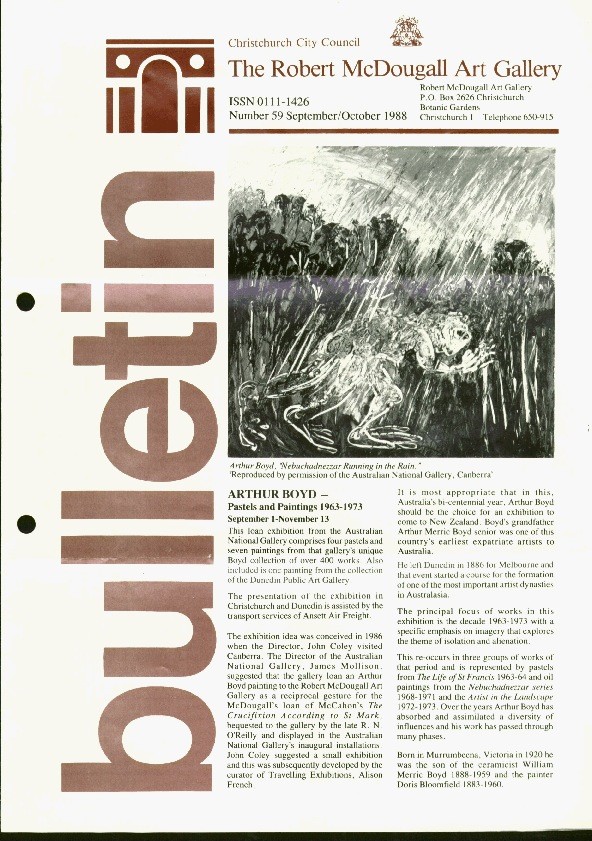This exhibition is now closed
Arthur Boyd: Pastels and Paintings 1963–73
1 September –
13 November 1988

This loan exhibition from the Australian National Gallery comprises four pastels and seven paintings from that gallery's unique Boyd collection of over 400 works. Also included is one painting from the collection of the Dunedin Public Art Gallery.
The presentation of the exhibition in Christchurch and Dunedin is assisted by the transport services of Ansett Air Freight.
The exhibition idea was conceived in 1986 when the Director, John Coley visited Canberra. The Director of the Australian National Gallery, James Mollison, suggested that the gallery loan an Arthur Boyd painting to the Robert McDougall Art Gallery as a reciprocal gesture for the McDougall's loan of McCahon's The Crucifixion According to St Mark, bequested to the gallery by the late R. N. O'Reilly and displayed in the Australian National Gallery's inaugural installations. John Coley suggested a small exhibition and this was subsequently developed by the curator of Travelling Exhibitions, Alison French.
It is most appropriate that in this, Australia's bi-centennial year, Arthur Boyd should be the choice for an exhibition to come to New Zealand. Boyd's grandfather Arthur Merric Boyd senior was one of this country's earliest expatriate artists to Australia.
He left Dunedin in 1886 for Melbourne and that event started a course for the formation of one of the most important artist dynasties in Australasia.
The principal focus of works in this exhibition is the decade 1963-1973 with a specific emphasis on imagery that explores the theme of isolation and alienation.
This re-occurs in three groups of works of that period and is represented by pastels from The Life of St Francis 1963-64 and oil paintings from the Nebuchadnezzar series 1968-1971 and the Artist in the Landscape 1972-1973. Over the years Arthur Boyd has absorbed and assimilated a diversity of influences and his work has passed through many phases.
Born in Murrumbeena, Victoria in 1920 he was the son of the ceramicist William Merric Boyd 1888-1959 and the painter Doris Bloomfield 1883-1960.
At an early age like the other members in his family Boyd drew and painted keenly. Up until he was 16 he worked for his uncle but then went to live with his grandfather Arthur Merric Boyd senior on the Mornington Peninsula.
He was encouraged by his grandfather who was primarily a watercolourist and they spent much time in the landscape painting together.
In 1937 Boyd moved to Melbourne where he undertook some brief formal training at the National Gallery School. During this time he spent weekends painting in the bush doing colourful impressionistic landscapes. That year he also held his first solo exhibition and became a member of the Contemporary Art Society.
Although conscripted into service in 1941 he continued to paint and exhibit. His work at this time began to depart from the landscape concern that had dominated the late 1930s.
Boyd has said of this painting, "from about 1940-1943 I did a group of paintings, imaginary poems, psychological or poetic fantasies perhaps".
From 1943 he continued to work with imagery that was more emotionally charged relating in particular to the conflict of human emotions.
There also emerged in the late 1940s, a fascination with the Flemish artist Pieter Brueghel, that began a series of biblical paintings that reflected his stylistic influence, but were carried out in Boyd's own time, placing religious subjects in the Australian landscape. The stimulus for this imagery was the bible stories read to him as a child by his grandmother.
At this time he was living back at Murrumbeena painting these large complex canvases. In 1948 he received his first mural commission and this marked a turning point in his career as he became completely reliant on his art for his livelihood. Between 1950 and 1953 Boyd worked as a ceramicist which resulted in further important public commissions but in 1955 he returned to painting. Up until 1959 he worked on the now celebrated 'Bride' series which centred around the theme of mixed aboriginal and white marriage.
In November 1959 he left with his family for London and the following year he held his first overseas exhibition at the Zwemmer Gallery. He continued to work out the 'Bride' series until 1962 when he once again returned to ceramics.
By 1964 he had begun experimenting with pastels and this coincided with his exploration of imagery based around 'St Francis of Assisi' set in the Australian landscape.
He worked on a total of 22 pastels on the life of St Francis between 1963 and 1964.
The paintings based on the biblical legend of the Old Testament king Nebuchadnezzar were started in 1968 and continued until 1973.
The dominant element that links both series of works is the ordeal of both subjects in the wilderness, and the testing of mankind against adversity.
This is something that the artist himself has experienced and realised in his confrontation with the awesome Australian landscape.
During most of the 1960s and 70s Arthur Boyd lived in London but in recent years has returned to Australia where his creative energy continues to be prodigious.
('Arthur Boyd: Pastels and Paintings 1963-1973', Bulletin, No.59, September/October 1988, pp.1-2)
Location:
Robert McDougall Art Gallery - main gallery
Exhibition number: 411
